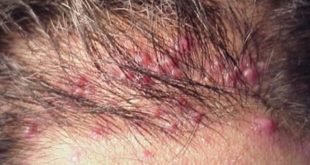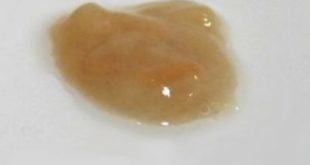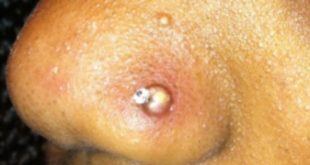Red moles can occur on the breast, scalp, skin and even all over the body. Their size can vary a lot. Some are small red moles while others grow into big bumps that are raised. Though they may not hurt, some moles may be painful. Here are the causes, removal treatment and ways to get rid of red bumps on your skin naturally.
What are red moles?
Contents
Red moles are small bumps that can occur in some areas of your body like the neck, face, chest or back. They are produced when the color producing cells in your skin grow in a cluster. They are normally round or oval, they can be raised or flat. They are small and bright color. Their onset is sudden and they may disappear the same way they came.
Red moles can be broken down into several types:
- atypical moles
- spits nevi
- actinic keratosis
- cancerous red moles
- melanocyte nevi
- cherry angiomas
The size and the intensity of the color of these moles vary from one to the other. Their characteristics will help you distinguish them.
The appearance of the moles on your skin may make you to panic or to worry. You should not worry because they are just symptoms of something in your body that is out of balance. The technical name used to refer to this condition is Nevus Rubi or Nevus cherry.
See also:
Most people who report moles on the skin are people of middle age. They appear to be externally small between 1 to 4 mm in size and they are reddish in color. They portray little importance and they may appear in the following parts:
- Neck
- chest or back areas
- genital areas
- legs
- underarms
Newly discovered moles can be very alarming, especially when they are paired with distinctive color. In most cases, moles on the skin are dark brown or black and therefore finding red moles on the skin can a real source of worry and concern. The fact that you may show red moles, you should not be scared of cancer of the skin.
The color, size and shape of a mole helps to distinguish a potentially cancerous mole from the one that is benign. Red moles are usually benign and mostly indicate that the skin is in the process of aging in the course of time.
1. Atypical moles
They range from light tan to dark brown. They are also known as dysplastic nevi. They include shades of red along with brown. These moles often include a mixture of colors that may appear speckled and they are usually flat or slightly raised.
The edges are normally irregular and the boarder fuzzy. They are on the other hand larger than other moles and they are often broader than the width of a pencil eraser. They can develop at any age and occur anywhere on the body, although they mostly occur on the back, chest and the scalp. These type of moles are common in fair skinned people and should be examined by a doctor to ensure they are not cancerous.
2. Spitz nevi
These are special types of moles that are often red, pink or light brown, although they can include a mixture of the colors. They are typically raised like a dome and tend to bleed if they are scratched. They most often develop on the following;
- head
- neck
- arms
- legs
They are usually half an inch across.
They develop in fair skinned people and normally appear in childhood, although they are likely to also occur in adults. These moles grow quickly but the good thing is that they are non-cancerous. It is at times hard to distinguish between cancerous moles from a spitz nevi. The doctor may be forced to remove the spitz nevus in order to be sure that it is not cancerous.
3. Cherry angiomas
They look like small red moles but they are not actually skin growths. According to Medline Plus, cherry angiomas are benign skin growths that consist of blood vessels. Medically known as Campbell de Morgan spots, the skin growths can appear at any location on the body but mostly the trunk. They can affect men and women and they are most common in people who are over 30 years old. Cherry angiomas are not cancerous. Since they are made up of blood vessels, they end to bleed if nicked.
4. Cancerous red moles
They start as brown or small red mole on the skin and then tend to change shape and size then spread. They are often larger than 6mm wide and are usually uneven in color with shades of black, brown and tan.
They are:
- irregular
- asymmetrical
- edges may be ragged, notched or blurred
- fade into the rest of the skin
- The skin may break down and look scrapped
- become hard and become bumpy or ooze blood
5. Melanocyte nevi
These are small growths of pigment cells on the skin and very commonly found in people younger than the age of 40 years. They can be congenital or acquired later in adulthood. They are all the same non-cancerous. They tend to fade away with age. They develop around the waist, on areas exposed to the sun and are normally smaller than 5 mm
6. Actinic keratoses
They are not necessarily moles but they may resemble them. They are normally;
- red brown
- rough
- irregular in shape
- with distinct edges of varying size
- typically scaly
Might flake off although they usually come back. They are precancerous and they may develop due to sun damage.
The areas likely to suffer greatly from this condition are the areas most often exposed to sun, including:
- nose
- Face
- ears
- scalp
- arms
They occur most frequently in fair skinned people and mostly develop in the late stages of adulthood.
The presence of red moles on your body do not hurt at all. It is only that they affect you aesthetically that you may raise alarm. They are not like common moles that may pose a great health risk. You should however pay attention to them and if they evolve, that is swell or grow in size, you should be aware of it and raise alarm soonest.
If you discover some sort of anomaly, is recommended that you go to a dermatologist since the red moles may also bleed from time to time.
What causes red moles on skin, body, scalp, and breast?
This type of mole on our skin usually appears suddenly due to some external causes that make blood vessels grow abnormally; this is caused by factors in our daily lives that promote this imbalance. The breakdown below provides a clear insight into the causes:
The cause of the overgrowth is unknown. But According to Meisenheimer, it is suspected that there is a genetic factor involvement because there are families developing more red moles than others. Compared to other regular moles, red moles are considered to be hereditary. If your ancestors or grandparents had harmless red moles, you will probably have the same. They also consist of excessive blood vessel growth.
Liver problems
It is known that one of the main reasons for the onset of red moles on our skin is that our liver is not functioning properly.
Poor diet
Unhealthy eating habits make a person’s body accumulate excess toxins that are stored in organs such as the liver or intestine. This could lead to poorly looking scalp or skin in general.
Sun exposure
Red moles may also appear because our skin has received too many UVA rays. We must be aware of this and learn to sunbathe safely. The surfaces exposed the sun like the scalp and face are likely to be affected highly.
Hormonal disorders
In the case of women, one of the causes of red spots is hormones. In periods of menstruation or pregnancy it’s likely that these skin marks will go away the same way the appeared. The imbalance would bring the moles on breasts as well as other parts of the body.
Age
Ageing also produces these moles. As you grow older, then the likelihoods of you developing red moles are also likely to go up. Care of the skin is therefore very essential as you age.
Anxiety, stress or depression
Psychological or emotional factors may be one of the factors that make these marks appear on the skin. Always relax and avoid unnecessary stressors as they contribute to varying amounts of your body hormones.
Painful red raised mole on scalp
A red mole on the scalp is not a sign of cancer, neither is it related to cancer. They don’t cause any serious medical problems. You should however make a point of seeing a dermatologist in case the mole undergoes any changes, become raised or painful. These changes include:
- Itches
- bleeds
- inflammation
The moles are caused by excessive concentration of blood vessels on the scalp. The cause for this remains unknown but genetic has always been seen as the biggest contributor. At the place on the scalp where the red mole causes no trouble, there should be no need for treatment.
In the event that the mole stands on your way during styling or shaving, then you can have it removed. The methods of removing it from your scalp are various as discussed later. In case the red mole on the scalp is cut, it can bleed profusely. It can also get readily infected. It is therefore important to be very cautious when handling them.
Small/little bright red moles meaning
The occurrence of small red moles on skin, also known as cherry angiomas, can certainly be alarming. However, while they may seem unsightly, this particular type of mole is usually harmless.
In most cases, people have small black or brown moles on the body which seem pretty harmless. But sometimes we get small red moles on skin, which bleed on being nicked. These tend to erupt in huge numbers after turning 30 years of age, look pretty scary and can cause concern. Many people start fearing that their red moles might be cancerous moles. They don’t know what to do and just want to get rid of them.
Most of the small red moles on skin that you see are pretty harmless. Sometimes they are present since birth, some of them develop over a period of time, whereas others develop and just disappear naturally. The black ones are considered a sign of beauty if they are present on the face or feet. And there is absolutely nothing to worry about unless you see them growing in size, changing color or becoming painful.
It is not known specifically what causes small red moles on skin to appear. It could be genetics or environmental factors affecting.
How to get rid of red moles
Usually no treatment for red moles is necessary, unless their location is bothersome. Generally, the lifespan of a red mole is about 50 years.
In order to prevent new moles from appearing, you will need to take care of your skin, especially if it is sensitive or very fair. The approaches below give you some brief information on how you can treat your skin to hinder moles from attacking you.
- Always protect it from solar radiation, especially in the summer and during the highest radiation hours, between 12 and 4 pm. and always use sunscreen but prevent exposure or cover your skin during midday.
- Do natural peels once a week or every fifteen week with proper products for your skin type and the sensitivity of every zone of your body.
- Hydrate and nourish your skin frequently with vegetables or natural hydrating creams.
- Use natural fabrics like linen or cotton and avoid synthetic fabrics.
- Have a balanced diet. Eat fruit, raw vegetables, and healthy fats every day. These will nourish your skin deeply and give it vitality.
- Shower with cold water whenever possible or at least end the shower with cold water to improve cutaneous and your body’s circulation in general. Very hot water weakens you and takes away your skin’s firmness.
All in all, some people prefer to first try some natural remedies because in this way they will avoid the discomforts of medical treatment and their high prices. The following are some natural remedies that could sort you out adequately:
Castor Oil
You will need castor oil, a cotton ball, and surgical tape. To do it effectively, follow the procedure as outlined below:
- Soak the cotton ball in the oil and apply it to the mole, securing it with the help of surgical tape.
- Change the cotton ball every day with a new one and do it for seven days in a row.
Garlic
Garlic has very powerful anti-inflammatory properties and because of its ability to remove warts, it works in a similar way in this case. To benefit maximally reap from the benefits, the procedure below would be essential:
- Apply a piece of fresh garlic every day to the mole and keep it in place with surgical tape.
- Change it twice a day preferably, in the morning and before you go to bed.
Sour Apple
To enjoy the benefits of the fruits, use the procedure below:
- Blend the juice from a sour apple and apply it to the mole at least three times a day for three weeks.
- This is a slow treatment that requires patience but it is effective and you will see how it disappears.
Skin changes dramatically as we age and since we can’t turn back time, prevention is the best possible solution. Below are some of the prevention techniques that you could consider to employ:
Always ensure that you hydrate yourself well. Ensure you always keep your body hydrated and exercise daily to increase circulation. Ensure that you always take at least 1.2 liters of water on a daily basis. The water will help to get rid of the toxins that might be in your body. In most cases, how healthy the skin speaks much of how healthy the internal organs of the body are.
Moisturize your skin from time to time frequently. Refill lost moisture in the skin with good quality lotions or night creams. Daily moisturizer also works as sunscreen if you apply it before makeup.
You could also use sunscreen for protection. This is of utmost importance to use a sunscreen with higher SPF to protect your skin from damage even if it is not summer and you don’t plan on sunbathing. If you are cooking long hours in front of kitchen stove, use a sunscreen lotion to protect your skin from heat.
Similarly, you can always detox. Take care of your liver. Small red moles on skin can be a result of eating disorders and unhealthy living. Add fresh vegetables to your diet. Lemon juice in water on an empty stomach has multiple cleansing benefits on the body.
Red mole removal
In case, you feel that you need to remove the small red moles on skin, there are options that you can try with the help of a qualified health personnel.
First of all you could dry it off
You can try this technique at home. Use iodine tincture or castor oil to dry off the small red moles on skin. Some may fall off themselves, others might need to be cauterized.
Chemical Peels and Dermabrasion
These are cosmetic procedures done on the skin for a number of purposes including treating wrinkles, discoloration and stretch marks. They remove the top layer of skin allowing new epidermis to grow in its place. They might not remove the small red moles completely but they will certainly help dim the color.
You can learn about different stretch mark removal options right here
If they are small, you can conceal them with concealers or makeup, although there are different medical treatments that allow you to remove them. In this case, you should consult your doctor or dermatologist so that they can tell you which would work best for you:
The other option is to carry out a surgery: this mainly applies to big and deep moles. It is done with a skin incision. The mole is extracted and then the area is stitched. It can be painful and tends to leave a scar.
Similarly, laser therapy is an able way to deal with this: this method is fast and painless and has barely no side effects. Laser or IPL is usually used for removing flat and pigmented moles. This method of mole removal may require about 3 treatments to make the mole invisible. The laser beam or pulsed light is selectively absorbed by the pigment of the mole, which is then destroyed and shed away.
Cryotherapy is yet another very suitable alternative: this option uses a nitrogenous liquid to freeze the mole and then extract it in the same way as warts are removed. The problem is that it is very pricey.


